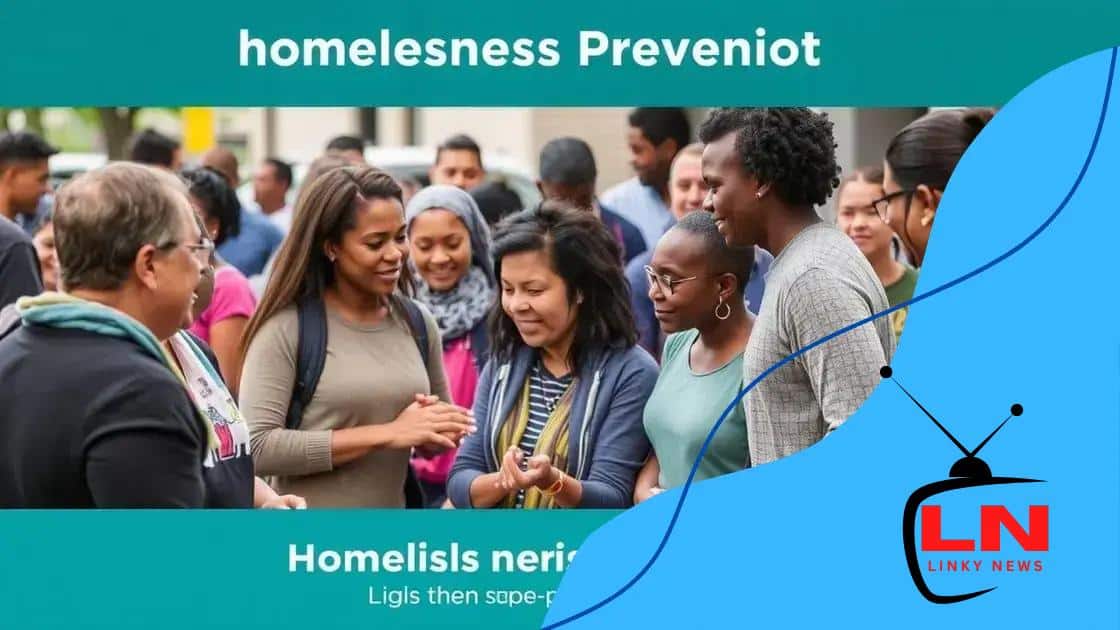Homelessness prevention efforts: how we can make a difference

Homelessness prevention efforts involve understanding root causes, implementing effective community strategies, utilizing government support, and leveraging local resources to create lasting solutions for those at risk.
Homelessness prevention efforts are more crucial than ever in today’s society. Have you ever thought about the small steps we can take to make a significant impact on our communities? Let’s explore how collective action can help change lives.
Understanding the causes of homelessness
Understanding the causes of homelessness is essential for effective prevention. It is not just about lacking a home; various factors contribute to this complex issue. By addressing these underlying causes, we can work towards solutions that truly help individuals and families.
The key drivers of homelessness
Several interrelated factors play a significant role in homelessness. Recognizing them is vital in creating comprehensive prevention efforts:
- Poverty: Many people become homeless due to financial instability. Losing a job or facing unexpected expenses can lead to eviction.
- Lack of affordable housing: The ever-increasing cost of housing makes it difficult for low-income individuals to find a place they can afford.
- Health issues: Physical and mental health problems can prevent individuals from maintaining stable employment, which may result in losing their homes.
- Substance abuse: Addiction can create a cycle of instability, contributing to homelessness. Access to quality treatment is crucial for recovery.
Additionally, societal issues such as discrimination and systemic inequality further compound these problems. Understanding the individual experiences behind the statistics is crucial to addressing homelessness on a larger scale.
When we dive deeper into the reasons for homelessness, we begin to see personal stories emerge. Each situation is unique, yet many share common threads that connect their struggles. It’s essential to approach this topic with empathy and a willingness to listen.
By bringing awareness to the causes, we can better engage communities in prevention efforts. Local organizations, governments, and individuals can work together to identify specific needs and create targeted solutions. Initiatives can range from job training programs to increased mental health support.
In this way, understanding the causes of homelessness allows us to advocate for change. When we are informed, we can push for policies that address these issues at their roots. Ultimately, recognizing these factors will enable us to support those in need and create lasting solutions.
Effective strategies for prevention
When discussing effective strategies for prevention, it’s important to consider collaborative approaches. Communities can only succeed when they work together to address the challenges of homelessness.
Community collaboration
Engaging local organizations, businesses, and residents is crucial. By pooling resources, communities can create a supportive network that offers diverse solutions.
- Housing-first initiatives: Providing stable housing is the first step in addressing homelessness. Programs focused on this approach show significant success.
- Job training programs: Helping individuals gain new skills can lead to stable employment, reducing the risk of homelessness.
- Mental health services: Access to mental health care can greatly impact those at risk. Support systems can help individuals cope and thrive.
- Financial literacy training: Teaching money management skills empowers individuals to make informed choices that prevent financial crisis.
As we explore these strategies, it’s clear that prevention is not a one-size-fits-all solution. Each community must assess its unique situations and adapt accordingly. Through collaboration, tailored programs can emerge that meet the specific needs of the population.
Education and outreach play a crucial role as well. Raising awareness about homelessness in local communities helps dispel myths and create empathy. Events such as workshops and informational sessions can engage the public and mobilize support.
Moreover, advocacy for supportive policies is essential. Community members can lobby local governments for funding and resources that sustain prevention efforts. When leaders understand the importance of these initiatives, they are more likely to allocate necessary resources.
Ultimately, employing effective strategies for prevention requires ongoing commitment and action. Success is achieved through a united front where everyone plays a part in fostering change.
Community resources and support systems

Community resources and support systems are integral to addressing homelessness. These networks provide the essential services and assistance that individuals need to regain stability.
Types of resources available
Many organizations and initiatives work tirelessly to support those facing homelessness. These resources often fall into various categories that can meet the diverse needs of individuals:
- Shelters: Temporary housing helps people find safety and security while they seek permanent solutions.
- Food banks: Providing essential nutrition allows individuals to focus on rebuilding their lives without the stress of hunger.
- Job placement services: Programs that connect individuals with employment opportunities can significantly improve their financial situation.
- Mental health and addiction services: Access to counseling and rehabilitation programs is vital for many who struggle with substance abuse or mental health issues.
Understanding how to access these resources is crucial for both those in need and the community. Local governments, nonprofits, and community organizations often publish guides or host information sessions to educate residents about available services.
Building a strong support system also involves collaboration among various groups. For example, schools and healthcare facilities can play a role in providing necessary information and directing individuals toward appropriate resources. By working together, community members can create an environment that fosters support and care.
Advocacy is another critical component. Community members can encourage local leaders to fund and support resources that address homelessness. Engaging with policymakers helps ensure that the needs of the community are met. This kind of grassroots effort contributes to more comprehensive solutions that effectively tackle the issue.
In summary, community resources and support systems play a significant role in helping individuals experiencing homelessness find their way back to stability. These efforts require an ongoing commitment from everyone in the community.
The role of government in prevention efforts
The role of government in prevention efforts is vital for addressing homelessness effectively. Governments at all levels have the responsibility to create policies and allocate resources aimed to support those in need.
Policy development
One major aspect of government involvement is the development of policies that address the root causes of homelessness. This includes regulations that promote affordable housing and financial aid for low-income families. By establishing laws that support housing stability, governments can help prevent individuals from falling into homelessness.
- Incentives for affordable housing: Governments can provide tax breaks and grants to developers who build affordable housing units.
- Emergency assistance programs: These programs support families facing eviction by offering short-term financial aid.
- Collaborative housing initiatives: Partnerships between governmental agencies and nonprofits can lead to innovative solutions for housing crises.
Funding is another crucial element. Governments need to allocate adequate resources for homeless prevention and support programs. This funding can be used for shelter, mental health services, job training, and health care. Ensuring funds are available can dramatically improve outcomes for individuals at risk.
Moreover, public awareness and community engagement are essential. Governments should lead initiatives that educate citizens about homelessness and advocate for supportive policies. Community events can foster compassion and encourage local participation in prevention strategies.
Beyond local governments, state and federal agencies have a role in shaping comprehensive strategies. Programs like the Continuum of Care (CoC) and Project HOME illustrate how multi-tiered approaches can bring together federal support and local implementation to combat homelessness on a larger scale.
The collaboration between different governmental levels can create a more efficient system. Sharing resources, best practices, and data helps streamline efforts and addresses homelessness more effectively.
In summary, the government’s involvement in prevention efforts is essential to creating lasting solutions to homelessness. Through policy, funding, and community engagement, governments can make a significant impact on reducing homeless rates.
Stories of success and hope in prevention
Stories of success and hope in prevention highlight the positive outcomes that can arise from effective efforts. These narratives inspire communities to act and provide insights into what works best in preventing homelessness.
Examples of successful initiatives
Many programs have shown that by combining resources, support, and commitment, communities can significantly reduce homelessness. These success stories often showcase innovative strategies that have led to meaningful change.
- Housing-first programs: One notable example is a housing-first initiative in several cities, where individuals are provided stable housing without preconditions. This approach has led to a decrease in homelessness and improved overall well-being.
- Job training programs: Many individuals have regained stability through job training initiatives. Programs that offer skills development and placement assistance have helped countless people find employment and maintain housing.
- Family support services: Stories from families who have received support services illustrate the importance of targeted assistance. Helping families navigate challenges, such as childcare and education, has kept them from falling into homelessness.
- Community engagement: Successful efforts often involve local residents working together. Grassroots movements have mobilized support, raised awareness, and created programs that reflect the community’s specific needs.
Personal accounts of individuals who have overcome homelessness can also be powerful. Their stories often highlight the struggles they faced and the support they received from programs and community members. These testimonials provide hope and demonstrate that change is possible for everyone.
Sharing these stories can encourage others to participate in prevention efforts. When community members hear about the positive impact of resources and support systems, they are more likely to get involved and advocate for continued assistance.
Thus, the stories of success and hope in prevention serve not only as testimonials of resilience but also as powerful reminders that everyone can play a role in addressing homelessness. By recognizing and celebrating these successes, communities can spark further action and inspire change.
FAQ – Frequently Asked Questions about Homelessness Prevention Efforts
What are the main causes of homelessness?
Homelessness is often caused by factors such as poverty, lack of affordable housing, health issues, and substance abuse.
How can communities help prevent homelessness?
Communities can help by offering resources like shelters, job training programs, and mental health services.
What role does the government play in preventing homelessness?
Government plays a key role by developing policies, funding support programs, and collaborating with local organizations.
Can success stories impact homelessness prevention efforts?
Yes, sharing success stories can inspire others to get involved and highlight effective strategies that work.





